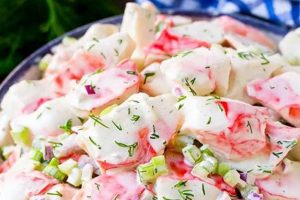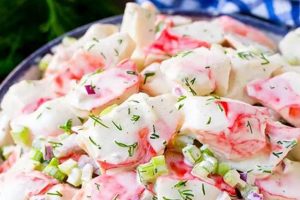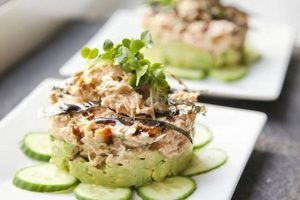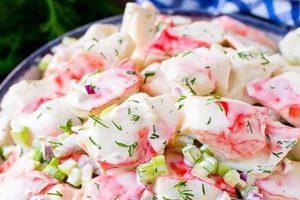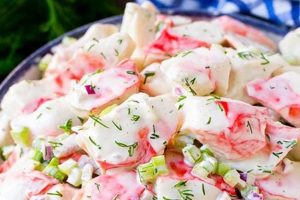A dish composed primarily of imitation crab, a processed food product typically made from surimi (minced white fish), combined with mayonnaise and various other ingredients such as celery, onion, and seasonings. A simple version might include only imitation crab, mayonnaise, and a dash of Old Bay seasoning, while more complex versions incorporate vegetables, herbs, and spices for added flavor and texture. This versatile dish can be served chilled as a salad, used as a sandwich filling, or enjoyed as a dip with crackers or vegetables.
This type of salad offers a convenient and affordable alternative to salads made with real crab meat. Its mild flavor profile makes it adaptable to a wide range of palates and allows for easy customization with various ingredients. Historically, surimi-based products gained popularity as a cost-effective substitute for shellfish, making dishes traditionally associated with more expensive ingredients accessible to a broader consumer base. This accessibility, combined with the dish’s ease of preparation, has contributed to its enduring popularity.
Further exploration of this topic will delve into specific ingredient variations, detailed preparation methods, nutritional information, and serving suggestions for different occasions.
Tips for Preparing Imitation Crab Salad
Achieving optimal flavor and texture in imitation crab salad requires attention to detail throughout the preparation process. The following tips offer guidance for creating a successful dish.
Tip 1: Thoroughly Drain Excess Moisture: Imitation crab often contains excess moisture which can dilute the flavor and create a watery salad. Pressing the imitation crab gently with paper towels before combining it with other ingredients helps achieve a desirable consistency.
Tip 2: Consider Texture: Dicing the imitation crab into uniform pieces ensures even distribution throughout the salad and creates a pleasant mouthfeel. Avoid over-processing, which can result in a mushy texture.
Tip 3: Balance Flavors: The mild flavor of imitation crab provides a neutral base for various seasonings. Classic additions include Old Bay seasoning, celery salt, and Dijon mustard. Experimenting with herbs, such as dill or chives, can enhance the flavor profile.
Tip 4: Choose Mayonnaise Wisely: The quality of mayonnaise significantly impacts the overall taste. Opting for a high-quality mayonnaise, or making homemade mayonnaise, elevates the flavor and richness of the salad.
Tip 5: Chill Before Serving: Chilling the salad for at least 30 minutes allows the flavors to meld and enhances the refreshing qualities of the dish. This step also firms the salad, making it easier to serve.
Tip 6: Add Crunch: Incorporating finely diced celery or water chestnuts introduces textural contrast and elevates the overall sensory experience.
Tip 7: Serve Creatively: While often served as a stand-alone salad, imitation crab salad can also be used as a filling for sandwiches, wraps, or deviled eggs, or served as a dip with crackers or crudits.
By following these tips, one can consistently create flavorful and satisfying imitation crab salad. Careful ingredient selection and attention to preparation details contribute significantly to the overall quality of the finished product.
These tips provide a foundation for successful imitation crab salad preparation. The following section will offer variations and serving suggestions.
1. Ingredients
Ingredient selection significantly impacts the final quality and character of imitation crab salad. The delicate flavor profile of imitation crab necessitates careful consideration of complementary ingredients. For instance, the subtle sweetness of imitation crab pairs well with the acidity of lemon juice, while the creamy richness of mayonnaise provides a cohesive base. The addition of crunchy vegetables, such as celery or diced bell peppers, introduces textural contrast, enhancing the overall sensory experience. Overly strong flavors, like raw onion or pungent spices, can easily overpower the subtle taste of the imitation crab, requiring judicious use.
The quality of ingredients also plays a vital role. Fresh, crisp vegetables contribute a bright, refreshing element, whereas wilted or older produce can negatively impact both flavor and texture. Using high-quality mayonnaise enhances the richness and creaminess of the salad, while lower-quality versions can result in a bland or overly tangy final product. Likewise, opting for name-brand imitation crab, often made with higher-quality surimi, typically yields a superior taste and texture compared to generic alternatives.
Understanding the interplay of ingredients is paramount for creating a balanced and flavorful imitation crab salad. Careful selection of fresh, high-quality components and thoughtful consideration of flavor pairings are crucial for maximizing the potential of this versatile dish. Experimentation with different ingredient combinations allows for customization and the development of unique flavor profiles, but a fundamental understanding of ingredient interaction remains essential for consistent success.
2. Preparation
Preparation significantly influences the final outcome of an imitation crab salad recipe. The process impacts texture, flavor integration, and overall presentation. Improper handling of the imitation crab, such as inadequate draining, can result in a watery salad lacking in flavor. Conversely, careful attention to moisture removal contributes to a desirable consistency and allows the other ingredients to shine. Chopping the imitation crab into uniform pieces ensures even distribution and prevents large, unappealing chunks. Consistent sizing also promotes even flavor distribution and enhances the overall aesthetic appeal of the salad.
Beyond the handling of the imitation crab itself, the preparation of other ingredients is equally important. Finely dicing vegetables, such as celery and onion, creates a pleasant textural contrast and prevents overpowering individual flavors. Over-chopping, however, can lead to a mushy texture, while leaving vegetables in large pieces can create an unbalanced eating experience. Proper emulsification of the mayonnaise-based dressing, typically achieved through gradual whisking, is essential for a smooth and creamy consistency. A hastily prepared dressing can result in a separated and unappetizing mixture. Furthermore, the order of ingredient incorporation can influence the final product. Adding more delicate ingredients, such as fresh herbs, towards the end of the preparation process preserves their vibrant flavors and prevents them from becoming bruised or wilted.
In conclusion, meticulous preparation is crucial for a successful imitation crab salad recipe. Each step, from draining the imitation crab to chopping vegetables and preparing the dressing, directly impacts the final dish’s flavor, texture, and presentation. Attention to detail throughout the preparation process elevates this simple dish from ordinary to exceptional. Overlooking seemingly minor details can compromise the overall quality, highlighting the importance of careful preparation in achieving a desirable outcome.
3. Flavor Balance
Flavor balance is paramount in a successful imitation crab salad recipe. The inherent mildness of imitation crab necessitates careful consideration of complementary flavors to create a palatable and enjoyable dish. A harmonious blend of tastes, encompassing elements of saltiness, acidity, sweetness, and umami, elevates the dish beyond its simple components. Understanding the interplay of these flavors allows for the creation of a complex and nuanced flavor profile that complements the delicate nature of the imitation crab.
- Saltiness
Salt enhances the inherent flavors of the other ingredients and provides a foundational savory element. While imitation crab often contains added salt, additional salt may be needed to achieve the desired level of saltiness. Sea salt or kosher salt are generally preferred for their clean flavor. However, excessive salt can easily overpower the delicate crab flavor, necessitating judicious use and careful tasting throughout the preparation process. The level of saltiness should complement, not overwhelm, the other flavors in the salad.
- Acidity
Acidity provides brightness and cuts through the richness of the mayonnaise, creating a more balanced and refreshing flavor profile. Lemon juice or a high-quality vinegar are common sources of acidity in imitation crab salad. The acidity balances the creamy texture and prevents the salad from becoming overly heavy. The type of acid used can also contribute subtle flavor nuances; for example, lemon juice imparts a citrusy freshness, while apple cider vinegar offers a slightly sweet and tangy note. The amount of acid should be carefully adjusted to achieve the desired balance without overpowering the other flavors.
- Sweetness
A touch of sweetness can enhance the overall flavor complexity and balance the savory and acidic elements. A small amount of sugar or a sweeter type of onion, such as red onion, can contribute this subtle sweetness. Alternatively, incorporating a finely diced apple or a few grapes can introduce both sweetness and textural complexity. However, excessive sweetness can detract from the savory nature of the salad, making careful portioning essential. The sweetness should complement the other flavors, not dominate them.
- Umami
Umami, a savory, brothy flavor, adds depth and complexity to the salad. Ingredients like a dash of Worcestershire sauce, a pinch of MSG, or a small amount of finely grated Parmesan cheese can contribute umami notes. These ingredients enhance the overall savory profile of the salad without overpowering the delicate flavor of the imitation crab. The umami element should be subtle, contributing to the background complexity of the flavor profile.
By carefully balancing these four primary tastes saltiness, acidity, sweetness, and umami one can create an imitation crab salad that is far more than the sum of its parts. The interplay of these flavors enhances the subtle sweetness of the imitation crab, resulting in a well-rounded and satisfying dish. Achieving this balance requires careful consideration of ingredient selection, mindful seasoning, and consistent tasting throughout the preparation process. The ultimate goal is to create a harmonious flavor profile that showcases the imitation crab while offering a complex and enjoyable culinary experience.
4. Texture
Texture plays a crucial role in the overall enjoyment of imitation crab salad. The inherent texture of imitation crab, often described as slightly chewy or flaky, forms the foundation upon which other textural elements are built. A successful recipe balances this inherent texture with contrasting elements to create a more dynamic and appealing sensory experience. This balance prevents the salad from becoming monotonous and enhances its palatability. For example, incorporating finely diced celery or water chestnuts introduces a satisfying crunch, contrasting with the softer texture of the imitation crab and the creamy mayonnaise. Similarly, adding chopped grapes or slivered almonds provides bursts of contrasting textures, elevating the overall eating experience. The interplay of textures creates a more engaging and satisfying culinary experience.
The size and shape to which the imitation crab is cut also influences the perceived texture. Larger chunks create a more substantial mouthfeel, while finely shredded crab offers a delicate texture. Dicing the crab into uniform pieces ensures even distribution of texture throughout the salad. This uniformity contributes to a more cohesive and enjoyable eating experience, preventing pockets of excessively chewy or overly soft areas. Furthermore, the consistency of the dressing contributes to the overall textural profile. A thick, creamy dressing clings to the imitation crab and other ingredients, creating a cohesive and rich mouthfeel. A thinner dressing, on the other hand, may result in a salad that feels watery or lacks substance.
Achieving a desirable texture in imitation crab salad requires careful consideration of ingredient selection, preparation techniques, and the interplay of different textural elements. Balancing the inherent texture of the imitation crab with contrasting crunchy, smooth, or juicy elements elevates the dish from simple to sophisticated. Attention to detail, such as proper chopping techniques and dressing consistency, ensures a harmonious textural experience. Failure to consider texture can result in a dish that is either monotonous or unbalanced, diminishing the overall enjoyment. A well-executed imitation crab salad, however, offers a delightful interplay of textures that enhances its appeal and contributes to a more satisfying culinary experience.
5. Serving Suggestions
Serving suggestions for imitation crab salad extend beyond the traditional presentation as a standalone dish. The versatility of this salad allows for its incorporation into a variety of culinary applications, expanding its potential beyond a simple side dish or appetizer. Creative serving suggestions enhance the appeal of imitation crab salad, offering diverse ways to enjoy its delicate flavor and adaptable texture. Understanding these varied applications allows for greater culinary flexibility and provides options for different occasions and palates.
- Classic Presentations
Classic presentations of imitation crab salad include serving it chilled on a bed of lettuce, accompanied by crackers or crudits. This simple approach highlights the salad’s refreshing qualities and allows the subtle flavors to shine. Variations within this classic presentation include the type of lettuce used crisp romaine or butter lettuce offering contrasting textural experiences and the accompanying elements, such as sliced tomatoes, cucumbers, or hard-boiled eggs. These subtle variations within the classic presentation provide options for customization and cater to individual preferences.
- Sandwiches and Wraps
Imitation crab salad makes an excellent filling for sandwiches and wraps. Its creamy texture spreads easily, while its mild flavor pairs well with various breads and fillings. A classic crab salad sandwich on toasted white bread offers a comforting and familiar option, while using croissants or whole-wheat bread provides textural and nutritional variations. Incorporating the salad into wraps with lettuce, tomato, and other vegetables provides a lighter and more portable meal option. These applications extend the versatility of the salad beyond a simple side dish, making it suitable for lunches, picnics, or quick meals.
- Appetizers and Hors d’oeuvres
The adaptable nature of imitation crab salad lends itself well to appetizer and hors d’oeuvre preparations. Spooning the salad onto endive leaves or cucumber rounds creates elegant and bite-sized appetizers perfect for parties or gatherings. Stuffing cherry tomatoes or deviled eggs with the salad offers another visually appealing and flavorful option. These smaller portions showcase the salad’s delicate flavors and allow for creative presentation, making them ideal for formal or informal entertaining.
- Stuffed Dishes
Imitation crab salad can add flavor and moisture to various stuffed dishes. Using it as a stuffing for avocados, tomatoes, or even baked potatoes elevates these simple dishes with added flavor and textural complexity. This application demonstrates the salad’s versatility beyond traditional presentations and offers a more substantial and satisfying meal option. The creamy texture of the salad complements the other ingredients, creating a balanced and flavorful dish.
These varied serving suggestions demonstrate the versatility of imitation crab salad and its adaptability to different culinary contexts. From classic presentations to more creative applications, the salad offers a range of options for incorporating its delicate flavor and pleasant texture into various meals and occasions. Understanding these serving suggestions allows for greater flexibility in meal planning and provides inspiration for innovative culinary creations. The adaptability of imitation crab salad makes it a valuable addition to any repertoire, offering a convenient and flavorful foundation for a diverse range of dishes.
6. Variations
Variations in imitation crab salad recipes demonstrate the dish’s adaptability and potential for customization. Exploring these variations reveals the interplay of ingredients and techniques that contribute to a range of flavor profiles and textural experiences. Understanding these variations allows for personalized adjustments based on dietary preferences, available ingredients, and desired culinary outcomes. Examining specific variations provides insight into the broader possibilities within this seemingly simple dish.
- Classic American Variation
This variation typically features mayonnaise, celery, onion, and Old Bay seasoning. It represents a widely recognized and readily accessible version, often served chilled as a salad or sandwich filling. Its simplicity makes it a popular choice for quick meals and casual gatherings. The emphasis on readily available ingredients contributes to its widespread appeal and adaptability.
- Asian-Inspired Variation
Asian-inspired variations often incorporate ingredients such as sriracha, sesame oil, ginger, and rice vinegar. These additions introduce a nuanced complexity, contrasting the traditional American profile with umami richness and a subtle heat. This variation reflects the growing influence of global cuisines and offers a more adventurous flavor experience. The use of these distinctive ingredients highlights the potential for cross-cultural culinary fusion.
- Mediterranean Variation
A Mediterranean approach might include ingredients like chopped olives, feta cheese, fresh dill, and lemon juice. This variation offers a lighter, brighter flavor profile compared to the richer, creamier American version. The emphasis on fresh herbs and citrus notes aligns with the Mediterranean diet’s focus on fresh, seasonal ingredients. This variation exemplifies how regional culinary traditions can influence and enhance a basic recipe.
- Low-Fat Variation
Health-conscious variations substitute Greek yogurt or light mayonnaise for traditional mayonnaise, reducing overall fat content without sacrificing flavor. Incorporating additional vegetables, such as chopped bell peppers or shredded carrots, further enhances the nutritional value and adds textural complexity. This variation caters to dietary restrictions and health-conscious consumers, demonstrating the recipe’s adaptability to specific needs. The substitution of ingredients highlights the potential for adapting recipes while maintaining desirable flavor profiles.
These variations highlight the adaptable nature of imitation crab salad, showcasing its potential for customization based on individual preferences and culinary goals. From classic American profiles to globally inspired interpretations and health-conscious adaptations, the range of variations underscores the dish’s versatility and enduring appeal. Exploring these variations provides a deeper understanding of the interplay of ingredients, flavors, and textures, ultimately enriching the culinary experience and expanding the possibilities within a seemingly simple dish.
Frequently Asked Questions
This section addresses common inquiries regarding imitation crab salad, providing concise and informative responses to clarify potential uncertainties and misconceptions.
Question 1: What is imitation crab meat made of?
Imitation crab meat, also known as surimi, is typically made from minced white fish, often Alaskan Pollock, combined with starch, egg whites, sugar, salt, and flavorings. It is designed to mimic the flavor, texture, and appearance of real crab meat.
Question 2: Is imitation crab meat healthy?
Imitation crab meat is a processed food and generally lower in protein and omega-3 fatty acids than real crab. It can also be high in sodium. However, it is a low-calorie and low-fat option. Nutritional content varies depending on the brand.
Question 3: How long does imitation crab salad last in the refrigerator?
Properly stored in an airtight container, imitation crab salad typically lasts for 3-5 days in the refrigerator. Spoilage signs include a sour smell, discoloration, or a slimy texture.
Question 4: Can imitation crab salad be frozen?
Freezing is not recommended as it can negatively impact the texture of the imitation crab, resulting in a watery consistency upon thawing. The mayonnaise-based dressing may also separate, affecting the overall quality of the salad.
Question 5: What are common allergens in imitation crab salad?
Individuals with shellfish allergies should exercise caution, as imitation crab can sometimes trigger allergic reactions due to cross-contamination or shared processing equipment. Additionally, the ingredients in imitation crab and the salad itself, such as eggs, wheat (in some imitation crab products), and soy (often found in mayonnaise), can be allergens for some individuals.
Question 6: How can one enhance the flavor of imitation crab salad?
Experimenting with fresh herbs, such as dill or chives, can elevate the flavor profile. Adding a dash of hot sauce or a squeeze of lemon juice introduces complexity. High-quality mayonnaise and freshly ground black pepper also enhance the overall taste experience.
Addressing these frequently asked questions provides a comprehensive understanding of imitation crab salad, encompassing its composition, nutritional aspects, storage, potential allergens, and flavor enhancement strategies. This information empowers informed choices regarding consumption and preparation.
This concludes the FAQ section. The following section will offer a complete recipe with step-by-step instructions.
Conclusion
Exploration of the imitation crab meat salad recipe has revealed a dish offering both convenience and adaptability. From ingredient selection and preparation techniques to flavor balancing, texture considerations, and diverse serving suggestions, the potential for customization is significant. Understanding the composition of imitation crab, addressing potential allergy concerns, and employing proper storage practices ensures both safe and satisfying consumption. The range of variations, from classic American profiles to globally inspired interpretations, further highlights the dish’s versatility.
The enduring popularity of imitation crab meat salad stems from its accessibility, affordability, and ease of preparation. Continued exploration of flavor profiles and innovative serving methods promises further evolution of this versatile dish, solidifying its place as a culinary staple.

